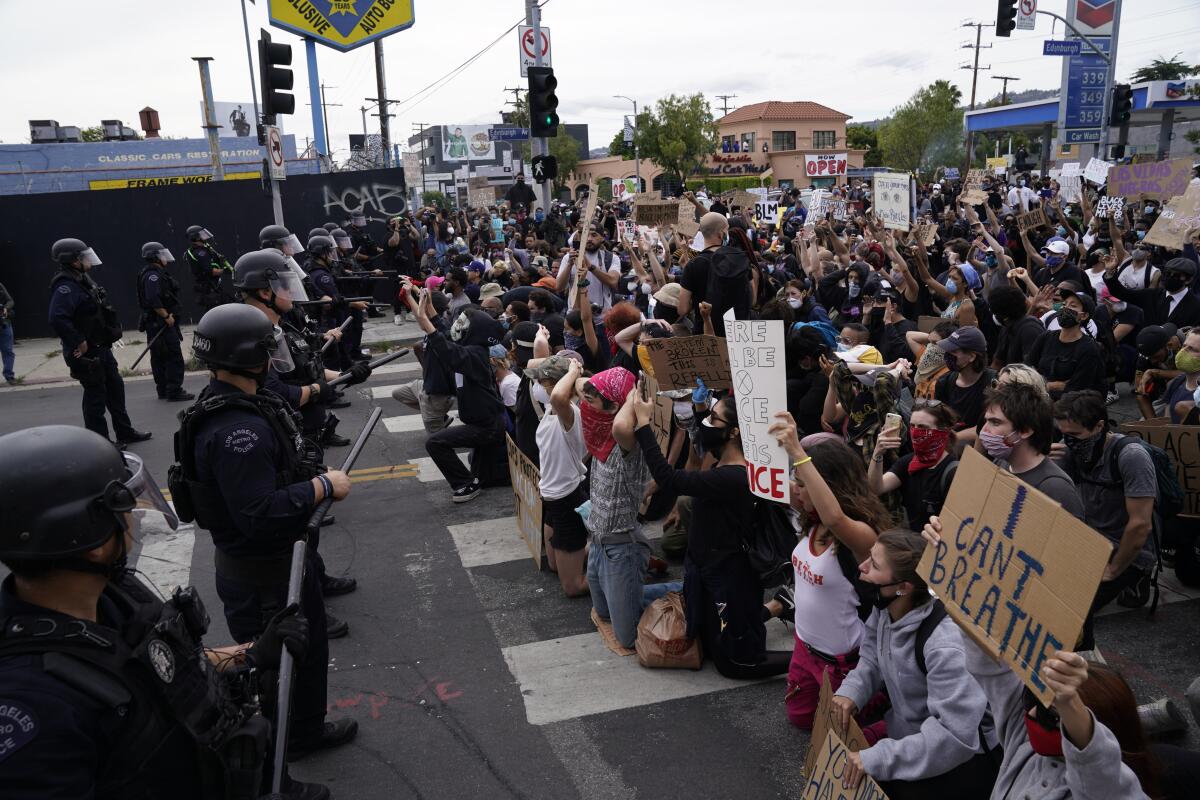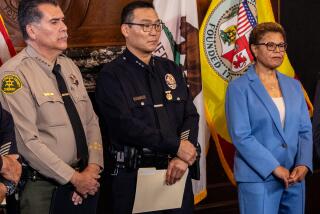Editorial: LAPD’s violence against protesters demands investigation

Policing is a difficult and dangerous job every day, but especially during protests that are pockmarked by serious theft and arson. Police chiefs and tactical commanders have to pay close attention to demonstrations as they progress to ensure that protests don’t descend into violence.
The most troubling scenes captured on video and replayed over the last two weeks, however, suggest that in many cases around the nation it was the police who unnecessarily escalated encounters with raucous but peaceful protesters, and the police who descended into gratuitous violence.
That includes the Los Angeles Police Department, which late last week stepped up its aggressive posture toward demonstrators.
As The Times has reported, protesters have complained of being shot with projectiles, clubbed, kicked and injured by officers merely for being present on the street during a protest.
One homeless man was shot in the eye with a projectile despite pleading with officers not to shoot, according to a lawsuit filed Friday.
Officers have arrested thousands of people, the vast majority of them for violating curfews and failing to disperse.
The excessive response undermines public confidence in the department’s leadership, including Chief Michel Moore, and its readiness for significant public safety challenges. The department’s tactics warrant serious investigation by the Police Commission.
The LAPD has a spotty history of dealing with protesters. The department has experts at dealing with isolated, small-scale demonstrations at which participants expect and intend to be arrested. It is only a small exaggeration to describe these as choreographed events. Officers all but explain to protesters, “Hi, my name is Mike, and I’ll be your arrested officer today. You may be in the bus a while so be sure to use the restroom before the arrest.”
But the department has failed miserably at dealing with larger, more vocal protests that occurred at high-profile events such as the Democratic National Convention in 2000 and the MacArthur Park immigration rallies in 2007. In both cases the LAPD had been enjoying a reputation for best-in-the-nation training and tactics, but lost control when confronting crowds of mostly peaceful protesters. Its apparent lack of planning and discipline in the heat of the moment resulted in injury to innocent participants and huge verdicts and settlements for use of excessive force.
More issues have surfaced at the LAPD this year. Investigations continue into the cases of officers who allegedly recorded people as gang members with no evidence of actual gang affiliation, in effect adding them to databases that make them more likely to be stopped and questioned by police without actual cause. And individual incidents of apparent excessive force continue plague the department, such as the beating of a homeless man during an April 27 arrest in Boyle Heights. The protests target these sorts of police actions, and not merely the death of George Floyd under the knee of a Minneapolis police officer on May 25.
Some protesters no doubt seek to provoke officers into displaying excessive force. But we expect them to resist taking the bait, and to raise their batons or their “nonlethal” weapons only as a last resort when confronting law-breakers.
We expect them to be able to distinguish between destructive criminals and lawful protesters, and not arrest the whole lot to be sorted out later. We also expect them to distinguish between destructive criminals and curfew violators, who may indeed be breaking laws when practicing civil disobedience but who are doing nothing illegal beyond being present. And we expect LAPD leadership then to distinguish between the vast majority of officers who behave properly and those who lose their cool under pressure.
It is noteworthy that Dist. Atty. Jackie Lacey announced that she will not prosecute protesters arrested for breaking curfew, and L.A. City Atty. Mike Feuer said he will take an alternative approach focused on engaging alleged violators in discussion but not prosecution.
These are both sound responses to the particular times and the particular alleged crimes. It would be foolish to take the thousands of arrested protesters to county jails, which are suffering from outbreaks of COVID-19 and which have intentionally reduced inmate populations to stem the infection rate. In the early days of the pandemic, Sheriff Alex Villanueva wisely called on local police departments to limit arrests to people suspected of truly dangerous acts, in order to keep the inmate count from growing unnecessarily.
Yet last week the LAPD stepped up its pace of arrests. And yes, people should indeed be arrested for suspected arson or other dangerous crimes. But nonviolent curfew violators are a different matter altogether.
More to Read
A cure for the common opinion
Get thought-provoking perspectives with our weekly newsletter.
You may occasionally receive promotional content from the Los Angeles Times.










